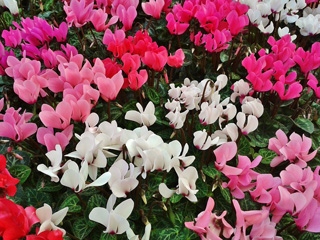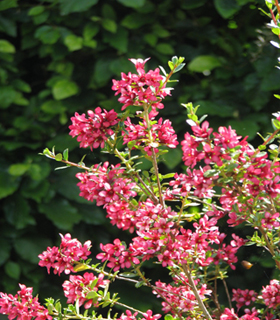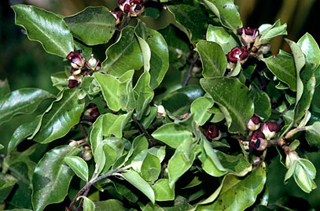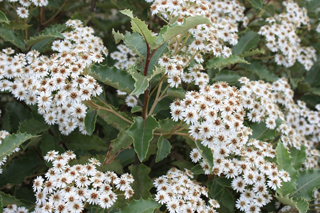 This is a funny period in the gardening year. Summer is almost over and our gardens are starting to look a little tired, but autumn is not quite here, despite some of the very dewy mornings we have had recently. It’s a sort of limbo time, when we gardeners are not quite sure which way to lean. Let us try and guide you a little.
This is a funny period in the gardening year. Summer is almost over and our gardens are starting to look a little tired, but autumn is not quite here, despite some of the very dewy mornings we have had recently. It’s a sort of limbo time, when we gardeners are not quite sure which way to lean. Let us try and guide you a little.
Many people have been coming into Pengelly over the last few weeks, asking for chrysanthemums, cyclamens, winter pansies, heathers, spring bulbs and the like, and the common response to our “not quite yet” is that they are in the big chain garden centres already. That may well be the case, but the big boys’ buying patterns are determined 12 months in advance, and they are competing furiously with each other to be the first to have things in.
Don’t do it – yet!!!
Our view is that it is better to look out of the window, check what the weather is doing, and then decide the best time for getting autumn and winter bedding in. Frankly, anyone who was quick off the starting blocks will probably have watched their autumn bedding crisp up and die over the last dry and hot week or so, with the exception of pansies and violas which love a splash of sun. It is simply still too warm for that sort of plant material to thrive well. Our advice would be, wait a couple of weeks longer and you will be rewarded. Besides, we are still shaking the sand from our beach towels, and who wants to be thinking about autumn when we can still do that?
 Having shouted, “Whoa Neddy” to you all on the bedding front, this is however a very good time to plan some shrub or evergreen hedge planting, if you have gaps to fill, or are planning a wholesale change in an area. As we eventually move into autumn (September and October principally) the soil remains warm and, hopefully, moist long after the air temperatures have started falling. This is an idea time to plant shrubby material, which will continue to develop root systems after the top growth has eased back for the year. This gives your plants a really good head-start for next year.
Having shouted, “Whoa Neddy” to you all on the bedding front, this is however a very good time to plan some shrub or evergreen hedge planting, if you have gaps to fill, or are planning a wholesale change in an area. As we eventually move into autumn (September and October principally) the soil remains warm and, hopefully, moist long after the air temperatures have started falling. This is an idea time to plant shrubby material, which will continue to develop root systems after the top growth has eased back for the year. This gives your plants a really good head-start for next year.
One of the most common requests we get is for advice on good coastal or wind-tolerant shrubs, either as part of a hedging shelter belt or standalone. A problem that arises is that “good coastal” often does not equate to beautiful or eye-catching. Let’s face it, coastal shrubs have a tough job to do, and they have to concentrate on having strong leaf structures and frequently give up beautiful flowers in return. It’s a compromise we have to accept.
Examples of good coastal plants include griselinia littoralis (littoralis actually means coastal) which comes in a couple of forms; a plain but bright apple green, and variegated. It is fast-growing, easy to propagate (seed or cuttings) and great for flower arrangements. Its flowers are insignificant, but see above for why! This will really do the job for you as shelter or a specimen shrub (it is easily shaped) but many argue is dull and uninteresting. We get that.
Elaeagnus, escallonia and larger forms of euonymus also make make very good hedging, and in the case of the first two, have noticeable flowers too. Escallonia comes in a range of white through to dark pink flowers which are tiny and horn-shaped, and very appealing to bees. Elaeagnus flowers are not so visible, but are deliciously scented, especially in the early evening. Again, good hedges or specimen shrubs
 Still too dull? How about olearia? This comes in several forms, quite different from each other to look at. What they do have in common are their grey coloured leaves, and small daisy-like flowers mostly in large clusters give some varieties their common name of daisy bush. They can be formed into large hedges, or individual specimens, and are just that bit different. Grey leaves are good for coastal, as a general guide.
Still too dull? How about olearia? This comes in several forms, quite different from each other to look at. What they do have in common are their grey coloured leaves, and small daisy-like flowers mostly in large clusters give some varieties their common name of daisy bush. They can be formed into large hedges, or individual specimens, and are just that bit different. Grey leaves are good for coastal, as a general guide.
Tamarix is also a great coastal due to its fine strappy habit – much more resistant to the salts or wind that is part of coastal living. It can form a lax hedge, if shaped well, but also looks nice as a medium shrub or small tree. Very pretty in spring, in pink or white forms.
 And finally, but by no means exhausting the full coastal hedging list, there is pittosporum, which comes in a plethora of forms and colours. We are lucky that it is hardy down here in the South West; not so in the frosty parts of the country. The classic grey-green pittosporum tenuifolium is quite vigorous and dense if pruned accordingly, and can perform the task of hedge, specimen shrub or tree beautifully well (Helen: I had blackbirds and sparrows nesting in one of mine this year – lovely to watch their comings and goings). It also has that secret weapon of wonderfully scented, tiny, almost black, flowers in autumn, followed by interesting seed pods. Pittosporum also comes in white variegation, dark purple, and many different shapes and sizes of leaf; something for everyone. Not all can perform the hedge and tree tasks, but all make lovely specimen shrubs. Very easily cut back hard and re-shaped too – most versatile. Explore this group; it is quite a surprising experience.
And finally, but by no means exhausting the full coastal hedging list, there is pittosporum, which comes in a plethora of forms and colours. We are lucky that it is hardy down here in the South West; not so in the frosty parts of the country. The classic grey-green pittosporum tenuifolium is quite vigorous and dense if pruned accordingly, and can perform the task of hedge, specimen shrub or tree beautifully well (Helen: I had blackbirds and sparrows nesting in one of mine this year – lovely to watch their comings and goings). It also has that secret weapon of wonderfully scented, tiny, almost black, flowers in autumn, followed by interesting seed pods. Pittosporum also comes in white variegation, dark purple, and many different shapes and sizes of leaf; something for everyone. Not all can perform the hedge and tree tasks, but all make lovely specimen shrubs. Very easily cut back hard and re-shaped too – most versatile. Explore this group; it is quite a surprising experience.
So that’s hedging, and you can of course, mix them all up for a less uniform effect but there are many smaller plants that work well in coastal gardens. We think we’ll save them for another day.
So, enjoy the last few warm evenings of the summer and we’ll see you in October, when the cyclamen and ‘mums really will be out in force and the vest will be back on.
Sarah Daniel and Helen Robins, Pengelly Garden Centre

